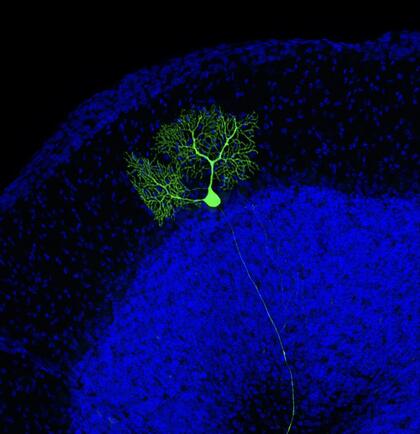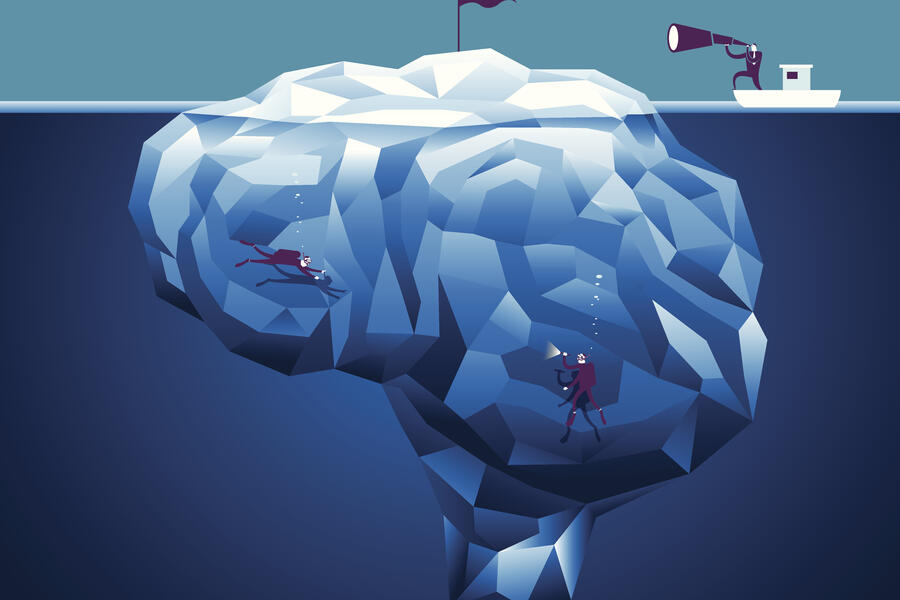It's one of nature's greatest ironies: the human brain lacks the ability to grasp its own complexity.
Indeed, the brain is complicated.
The three-pound organ housed in our heads consists of roughly 86 billion neurons. Each neuron connects to 10,000 other neurons, creating a seemingly infinite array of synaptic connections—estimated in the ballpark of 100 trillion—that make us who we are as individuals.
Despite gains made by neuroscientists in uncovering the brain's intricacies, much remains unknown, from the precise mechanisms involved in memory formation to the role of genes in brain development.
Today, however, advancements in neural probes, machine learning, and artificial intelligence are "revolutionizing our understanding of the brain and making it possible to probe brain function in ways we never thought possible before," says Johns Hopkins neuroscientist Richard L. Huganir.
That's why Huganir and his colleague Patricia Janak, a biological psychologist, teamed up to launch OneNeuro, an initiative that brings together researchers and practitioners from across the university to help decode the complicated control center between our ears.
"Our goal is to stop at nothing short of a complete understanding of the brain, from the molecular level to the cognitive and behavioral levels," says Huganir, a Bloomberg Distinguished Professor who directs the Solomon H. Snyder Department of Neuroscience at the Johns Hopkins School of Medicine and is also a professor in JHU's Department of Psychological and Brain Sciences. "It won't happen overnight, but it can happen over time with the right people, technologies, and organizational systems."
Specifically, the work requires a focus on basic research with "cross-disciplinary expertise and unprecedented collaboration among neuroscientists, engineers, computer scientists, data scientists, neurologists, neurosurgeons, psychiatrists, cognitive scientists, psychologists, philosophers, and others," says Janak, a Bloomberg Distinguished Professor with appointments in JHU's School of Medicine and Krieger School of Arts and Sciences. Johns Hopkins has the expertise, she adds. It's just a matter of creating the structure and synergy to make it happen.
"The OneNeuro initiative renews and reinforces Johns Hopkins' long-standing commitment to unraveling the mysteries of the human brain," Provost Ray Jayawardhana says. "By harnessing the collective expertise of our world-class neuroscientists, engineers, data scientists, and clinicians, we're poised to make unprecedented strides in understanding brain function and developing innovative therapies. This initiative embodies the essence of our One University vision, fostering collaboration across disciplines to tackle one of the most complex challenges in modern science."
Right now, more than 1,000 faculty members, postdoctoral fellows, and graduate and undergraduate students at Johns Hopkins pursue neuroscience-related research, whether at the molecular, cellular, systems, behavioral, computational, or clinical level. Neuroscience and biomedical engineering are two of the five most popular majors for Hopkins undergraduates.
The new brain initiative builds on the promise of the Johns Hopkins Kavli Neuroscience Discovery Institute that launched in 2016 to foster partnerships among neuroscientists, engineers, and data scientists working on the brain and behavior. OneNeuro expands the collaboration to take advantage of the university's deep expertise and resources in brain-related medical care and mental health services—and data-driven discovery through the recently launched Johns Hopkins Data Science and AI Institute.
In addition, Johns Hopkins will add six new junior faculty positions in neuroscience, plus six new Bloomberg Distinguished Professors with expertise in both neuroscience and another discipline, creating the Brain Resilience Across the Lifespan BDP Cluster. The added talent of top neuroscientists with experience thinking beyond the confines of their discipline will contribute significantly to OneNeuro, Huganir says.

Image caption: Here, a single Purkinje cell in the mouse cerebellum has been tagged genetically with Green Fluorescent Protein. The cell body and dendritic arbor are in the upper part of the image, and the long axon is in the lower part of the image.
Image credit: From Jeremy Nathans' lab in the School of Medicine's Department of Molecular Biology and Genetics
"The brain is one of the last major frontiers in biology," Janak says. "It's a mystery and a great challenge for the future, given that effective therapies and treatments for many brain disorders—both neurological and psychiatric—do not currently exist. This creates a huge gap that we're trying to fill."
Advancements in technology are key to making progress, Janak and Huganir contend. For instance, in vivo neural probes developed in the last decade enable scientists to measure brain activity far more precisely—and in much greater volume—than ever before. But the data sets retrieved by these probes "are too big for humans to analyze without help from data science and AI," Janak says.
In Janak's lab, neuroscientists use a tiny neural probe implanted in rat brains to investigate the behavioral and neural mechanisms of addiction. "These probes are a major advance for understanding brain function, including things like learning, memory, and addiction," Janak explains. "They make it possible to record data from hundreds to thousands of neurons at the same time in awake, behaving animals."
That is a game-changer.
Biomedical engineer Tim Harris, a research professor at the university's Whiting School of Engineering, led the team that developed these probes through his role as applied physics director at the Janelia Research Campus of the Howard Hughes Medical Institute (HHMI) in Ashburn, Virginia. There, Harris' team created the first of these probes, Neuropixels, in 2017—a breakthrough that made it possible for neuroscientists to simultaneously record cellular activity across multiple brain regions, all through a minuscule silicone implant that is thinner than a human hair. Now, close to a dozen labs across Hopkins use Neuropixels (and the various iterations of the technology released by HHMI) to make new discoveries.
Video credit: Imaging millions of synapses in the mouse brain to better understand the mechanisms underlying learning and memory in health and disease. Courtesy of Austin Graves, Gabrielle Coste, and Richard Huganir.
Janak and her team use the probes to look at "neural activity in brain areas known to be important in drug craving, with a goal of pinpointing what happens as animals transition in and out of a state of high motivation for a drug," she says. The neural recordings result in a treasure trove of information, with "tons of data streaming in every second as animals move, think, feel, and react to stimuli in the environment."
But making sense of the large, complex datasets doesn't fall within the wheelhouse of many neuroscientists. "It requires expertise from computer programmers, statisticians, data scientists, and AI specialists," Janak says. "Ultimately, this is the purpose of OneNeuro—to foster and coordinate collaboration in areas needed to do the work of advancing human knowledge of the brain."
Huganir and Janak say they consider JHU a highly collaborative university, "but those of us involved in the varied aspects of brain research don't always know each other and realize how our work overlaps," Huganir says. Creating a community of researchers, trainees, and practitioners with different levels and areas of expertise is key to, and already a core part of, OneNeuro's plan.
"We're building a unique community at Hopkins that is unified across all scales of neuroscience research, from the most granular level, molecules, up to how it all comes together to support the mind," Janak explains. Given the tall task, an interdisciplinary approach that uses basic research to help decode the brain is a necessary precursor to transitional (or applied) research and treatment development to come, Janak and Huganir say. This, they say, is a key goal of OneNeuro.
To build such a community, OneNeuro offers events for researchers to meet, chat, and spread awareness about their work, including a seminar speaker series with guest speakers from Johns Hopkins and other institutions. Earlier this summer, JJ Kim, a combined medical and doctoral student in neuroscience enrolled in Johns Hopkins' Medical Scientist Training Program, presented his work on myo-optogenetics, a technique that uses light to manipulate the activity of neurons and move muscles.
Among other seminars this past year:
Kellie Tamashiro and Frederick Barrett, professors in the School of Medicine's Department of Psychiatry and Behavioral Sciences, discussed the brain's reaction to the psychedelic psilocybin and its use in treating mood and substance use disorders.
Leyla Isik, a cognitive scientist at the Krieger School, and Tomomi Karigo, a neuroscientist at the School of Medicine, presented on the brain's perception of social interaction and the neural basis underlying social situations.
Amy Bastian, a neuroscientist and the chief science officer and director of the Kennedy Krieger Institute's Center for Movement Studies, discussed human movement disorders, and Andrew Gordus, a biologist at the Krieger School, shared findings on the mechanisms of spiders spinning webs.
"OneNeuro's speaker series intentionally brings together researchers from different perspectives to build the cohesive community we know is critical to our mission," Huganir says. And it's working.
When Bastian and Gordus presented talks on movement, for instance, the two were excited to discover commonalities among human and spider movement and motor control. "You would think those two areas would not be related to each other, but there's actually a lot of overlap, and that is interesting," Huganir says.
After each seminar, OneNeuro hosts happy hours to give speakers and attendees opportunities to meet and talk in a casual setting. Already through the series, "I've had amazing conversations, I've made new friends and potential colleagues, and we are averaging about two new collaborations per event," Huganir adds.
Of course, securing funding for cross-disciplinary basic research is another prerequisite to OneNeuro's success—and it's happening, thanks in part to a partnership with the Office of the Provost to provide funding through the Johns Hopkins Discovery Awards. Every year, researchers affiliated with OneNeuro are locked in to receive three Discovery Awards, each amounting to $150,000, rather than the standard grant of $100,000.
The three for OneNeuro this year are:
A project that examines hair cell regeneration by biologist Erin Jimenez and neuroscientist Angelika Doetzlhofer.
An investigation of the biomarkers of autism spectrum disorder by neurotoxicity expert Lena Smirnova, pediatrics research scientist Sarven Sabunciyan, and neurologist and research scientist Constance Smith-Hicks.
A study on sleep need and sleep deprivation by neuroscientist Seth Blackshaw, microfluidics expert and mechanical engineer Soojung Claire Hur, and neuroscientist and neurologist Mark Wu.
In addition, six other teams conducting neuroscience-related research received a 2024 Discovery Award. Their research ranges from the neural architecture of psychedelic experiences to the use of neural probes to provide insight on the cortico-striatal-basal ganglia loop, a system of neural circuits involved in movement disorders like Parkinson's disease and mental health conditions like obsessive-compulsive disorder.
According to Huganir, "OneNeuro's uniquely interdisciplinary approach to deeply understand the brain is critical to the future development of treatments to prevent or cure brain diseases and optimize brain function in all humans."
With new and emerging technologies and machine learning at their fingertips, plus existing broad expertise and an influx of top talent to come, OneNeuro is primed to do exactly that.
Visit OneNeuro's website and sign up for its newsletter to find out more.
Posted in Science+Technology








